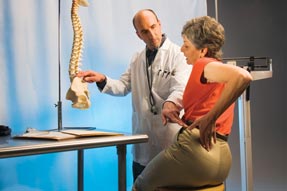MKSAP Quiz: Evaluation for a skin eruption
A 47-year-old man is evaluated for a skin eruption. Approximately 2 weeks ago, his wife noted an erythematous macule on his back. Over the ensuing week, the site became progressively larger. He notes mild fatigue but no fevers. He recently returned from a vacation in Massachusetts, which included outdoor activities such as bike riding and walking to the beach. He reports no known tick attachment.
On physical examination, temperature is 37.2°C (100.0°F), blood pressure is 117/68 mm Hg, pulse rate is 52/min, and respiration rate is 18/min. The skin lesion is shown.

Which of the following is the most appropriate management?
A. Prescribe doxycycline
B. Prescribe levofloxacin
C. Serologic testing for Babesia microti
D. Serologic testing for Borrelia burgdorferi
Answer and critique
The correct answer is A: Prescribe doxycycline. This question can be found in MKSAP 17 in the Infectious Disease section, item 85.
This patient has an enlarging erythematous skin lesion with central clearing suggestive of erythema migrans and should be prescribed doxycycline. Erythema migrans is the most common presentation of Lyme disease, seen in up to 80% of patients, although an initial heterogenous patch of erythroderma is more common than the classic target-like appearance. Erythema migrans is often the only manifestation of early localized Lyme disease because fevers or constitutional symptoms are uncommon at this stage. Treatment of early stage Lyme disease with doxycycline prevents progression to later-stage cardiac, neurologic, or rheumatologic complications in more than 90% of patients. Amoxicillin or cefuroxime axetil could be alternative options for the treatment of Lyme disease; however, these agents have not been evaluated for the treatment of southern tick–associated rash illness (STARI). STARI also presents as erythema migrans and can be identical to Lyme disease. Therefore, in a patient presenting with erythema migrans, treatment with an oral antibiotic active against localized Lyme disease and STARI, such as doxycycline, would be most appropriate.
Babesiosis is a parasitic disease that is spread by the same tick as Lyme disease but does not cause erythema migrans. Although coinfection with Borrelia burgdorferi can occur, serologic testing is not recommended in the absence of signs or symptoms, which include fever, jaundice, and scleral icterus. Lyme disease and human granulocytic anaplasmosis coinfection has also been reported; however, doxycycline is active against the bacterium causing this infection as well.
Laboratory testing for Lyme disease is insensitive at the early stage of infection, with less than 50% of patients having detectable titers to B. burgdorferi. In addition, laboratory confirmation is not necessary when erythema migrans is present.
Key Point
- Early localized Lyme disease and southern tick–associated rash illness present with erythema migrans and are clinically indistinguishable; therefore, patients with erythema migrans should be treated with doxycycline, which is effective in both conditions.





